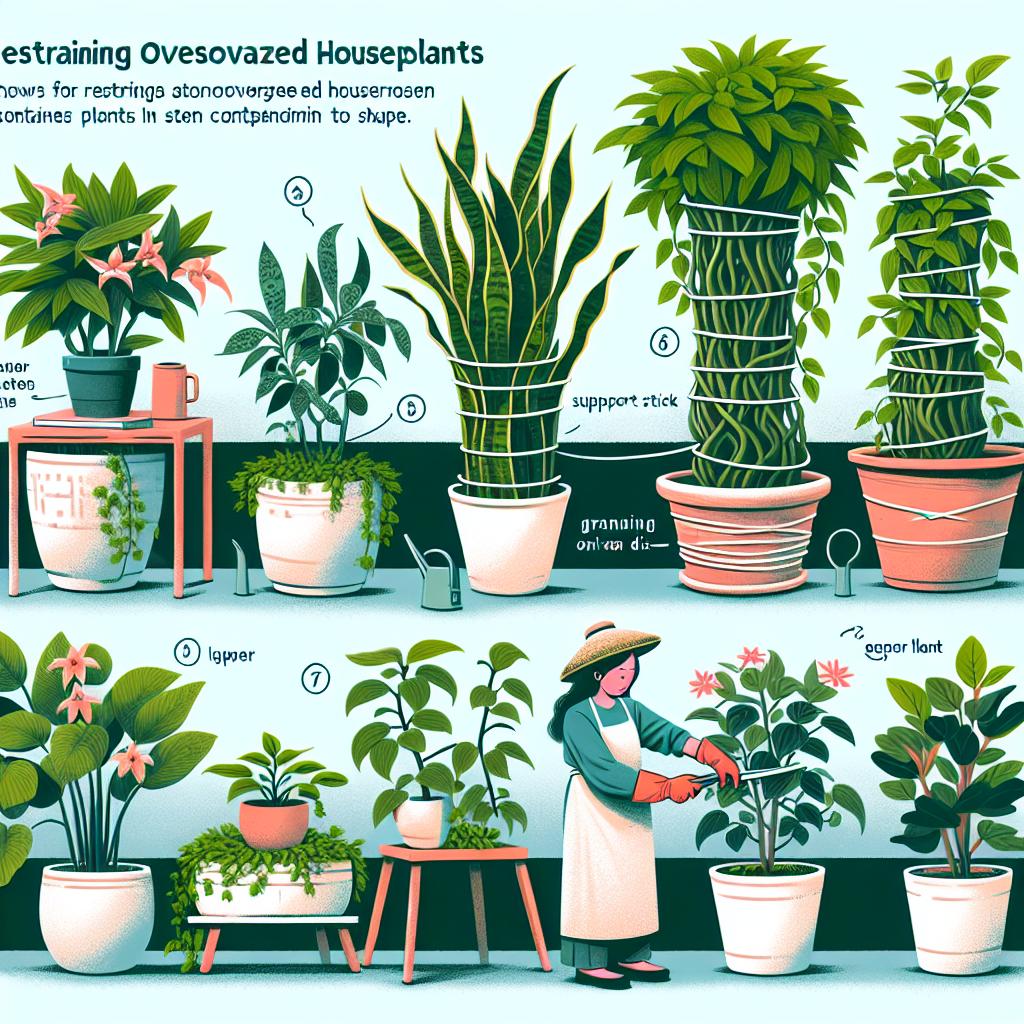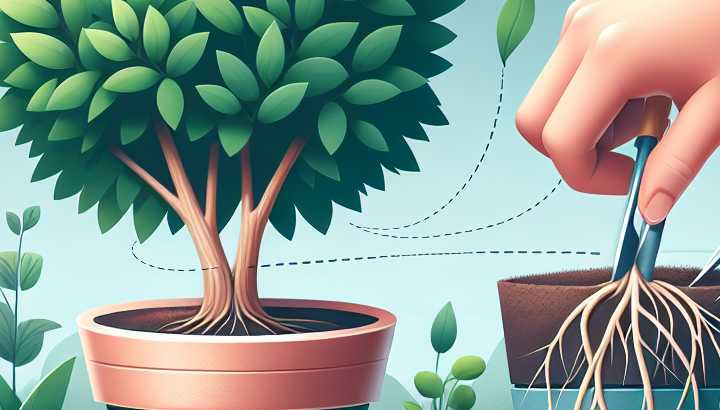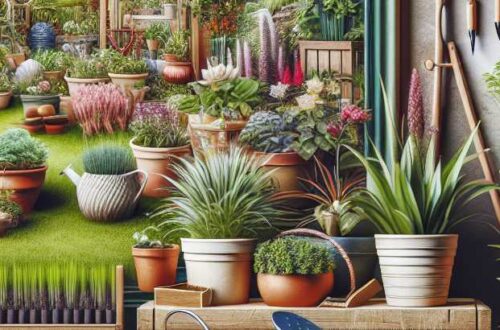Prevent Oversized Houseplants with Root Pruning Techniques

Understanding the basics of root pruning for houseplants
Title: Unveiling the Green Mysteries: Root Pruning Basics for Houseplants
Every urban horticulturist knows the simple joy of nurturing houseplants, watching them grow and thrive inside their cozy homes. However, there may come a time in your green endeavor when your leafy companion’s growth plateaus, the plant showing signs of distress despite your dedicated care. This might be the opportune moment to introduce you to a possibly less-traversed territory in indoor plant-care: root pruning.
Just like you’d pinch back spent blossoms or trim yellowing leaves to help your plants prosper, there might be moments when a plant’s roots need a little trim to preserve its vitality. Yes, it might sound a little daunting initially, but armed with the proper tools and guidance, you will master this skill in no time. So, let’s demystify the process of root pruning for houseplants.
Understanding Root Pruning:
Root pruning is precisely what it sounds like: trimming the roots of a plant. The aim is to foster healthier growth, improve nutrient absorption, or to fit the plant back into its pot. Some fast-growing houseplants, such as Anthuriums and Pothos, can outgrow their container quickly, leading to root bounding. If left unchecked, these congested roots can strangle the plant, eventually stifling growth and overall health.
The Right Time to Root Prune:
Choosing the right time for root pruning is pivotal. Ideally, the best time to prune a plant’s roots is during its most vigorous growth stage – for most indoor plants, this is over the spring and summer months. Trimming roots during dormancy could cause unnecessary stress, potentially damaging your green companion.
Preparing for Root Pruning:
Tools you’ll need are quite basic: sharp, clean scissors or pruning shears, fresh potting soil, a pot if your current container is cramped, and gloves to protect your hands.
Steps to Root Prune:
1. Unearthing the roots: Start by gently removing the plant from its pot. Take care to minimize any damage to the roots.
2. Examining the roots: Take a moment to study the root system.
“We can’t turn the ball over 20 times with two seniors and an experienced junior guard. I just told them I don’t want to hear any more about rankings or what we’re supposed to do. We have to get back to the basics and start doing the things again that we were doing early in the season.”
~ Shawn Purlee
Look for any brown or mushy roots, indicating disease or over-watering. Healthy roots have a firm, white appearance.
3. Pruning the roots: Using your shears or scissors, start trimming the roots. Remove any diseased areas first. Then proceed to trim back around a third of the root mass. Make sure to cut evenly around the root ball, preserving its overall shape.
4. Repotting: Once trimmed, your houseplant is ready for repotting. Use fresh potting soil and consider upgrading to a larger pot if the previous one was too snug.
Aftercare:
Post-pruning, your plant might appear a bit shell-shocked. Remember, this is a somewhat traumatic experience for your plant. Reduced watering is needed as the root system is smaller now. Regular monitoring for signs of distress is critical. However, with the right aftercare, your houseplant will rebound from the experience, growing stronger and healthier.
Root pruning might appear as a harsh practice for houseplant care, but remember, it is often employed as a crucial lifesaving measure. Halting root bound conditions, treating root disease, and creating a healthier environment for your plant are all benefits of this procedure.
Now that we’ve pruned away your apprehensions, you are better equipped to handle this seemingly intricate practice. By incorporating these insights into your plant-care regime, you will be well on your way to owning the finest, most glorious indoor greenery, brimming with good health, vitality, and abundant growth. Happy Pruning!
Like This? Try: Understanding The Basics Of Root Pruning For Houseplants

Techniques for preventing oversized houseplants
Title: Masterful Moves to Muzzle Mammoth Houseplants: Techniques for Preventing Oversized Houseplants
Introduction
Lush, vibrant houseplants are one of the most idyllic ways to transform your home into a serene oasis. They purify the air, enhance your interior aesthetics and even improve your cognitive functions. However, keeping them under control can sometimes pose a challenge, especially if they make an unabashed sprint towards the ceiling! Managing and preventing oversized houseplants requires both understanding their needs and taking necessary measures. Let’s delve into the easy-to-follow guidance to prevent your beloved green friends from becoming overgrown.
Understanding Houseplant Size
To begin with, it’s important to recognize that some houseplants are genetically predisposed to achieving larger sizes. That Monstera Deliciosa you love will indeed grow monstrous if you allow it. Understand the inherent traits of each houseplant you choose. Google the species, read about their typical size, growth pattern and optimal growing conditions. Understanding their traits will equip you with the knowledge to manage their growth better without hindering their health.
Pruning and Pinching
The primary technique for managing your plant’s size is pruning and pinching, often seen as the gardener’s best friend. Pruning involves cutting back overgrown branches and stem portions, while pinching entails removing the tips of stems to promote bushier growth. Regularly incorporated, these practices can prevent your houseplants from growing unwieldily, and instead, prompt them to grow fuller and bushier.
Regulating Nutrition Intake
One might assume that providing excessive amounts of sun, water, and houseplant fertilizer will contribute to stronger plants. On the contrary, over-enthusiastic feeding can cause rapid, uncontrollable growth. Regulating their nutrition intake, therefore, is key to managing their size. Ensure your plants are receiving an appropriate amount of light based on their species and water them according to their unique needs. Similarly, use fertilizers judiciously.
“A lot of printing techniques started to come together in the ’90s. Now the technology is really grabbing hold. It has advanced that the quality is so much better than what we saw years ago.”
~ Bill Benedict
Excessive nutrition can trigger rapid growth, leading to oversized houseplants.
Proper Plant Positioning
Where you ultimately place your plant can play a significant role in its growth. Most houseplants thrive in bright, indirect light. However, if given too much direct sunlight, some species will seize the opportunity to grow rapidly. On the contrary, designating them too-shady a spot curbs their natural ability to photosynthesize, stunting their growth. To prevent an oversized houseplant, strike a balance by placing your greenery in an area with moderate, filtered light, tuning it according to the plant’s specific needs.
Pot Size Control
The size of your plant’s container significantly impacts its growth. An overlarge pot invites the plant to expand indefinitely, while a pot too small may stunt growth or result in an unbalanced, topple-prone plant. A good rule of thumb is to choose a pot that’s two inches bigger in diameter than the previous one. This allows room for the plant to grow without it expanding excessively.
Rotation Regularly
Rotate your plants every week or two to ensure all sides receive an equal amount of sunlight. This encourages even growth and prevents the houseplant from becoming lopsided or growing too much in one direction. For rotation, turn your plants slightly each time you water them, ensuring they receive even exposure.
Conclusion
Mastering the delicate balance of nurturing houseplants without enabling them to outgrow their designated spaces equips you with the ability to enjoy the benefits of lush greenery without the worry of them turning into towering titans. By understanding your plant, managing its nutrition, and employing the practical techniques of pruning, pinching, pot sizing, and rotation, you can handle even the most ambitious of houseplants. So, ready your pairs of pruning shears and embrace your indoor gardening adventure with a newfound confidence!
Learn More Here: Techniques For Preventing Oversized Houseplants

Impacts of oversized houseplants and root pruning
Title: Unearthing the Impacts of Oversized Houseplants and the Vitality of Root Pruning
In the vast and verdant world of indoor horticulture, houseplants have carved a niche for themselves as an essential element of interior design and mood regulation. They serve as a living, breathing ornamentation that introduces not only an aesthetic appeal but also specific health benefits. However, concerns arise when the flourishing foliage starts outgrowing its environment, leading to vital conversations around oversized houseplants and root pruning.
𝑂𝑣𝑒𝑟𝑠𝑖𝑧𝑒𝑑 𝐻𝑜𝑢𝑠𝑒𝑝𝑙𝑎𝑛𝑡𝑠: A Green Giant in Your Living Space
Healthy growth is always welcome, but when your houseplants expand beyond their allowed space, they can introduce unexpected obstacles. Oversized houseplants can encroach upon your area, making navigation difficult and even posing a risk of toppling over, which can potentially destroy the plant or cause injury.
Aesthetically, a plant outgrowing its pot can ruin the balance and design of your interior decor. The elements that were once harmonious can turn chaotic with unruly foliage cramping the area. Additionally, oversized houseplants can obstruct sunlight access for smaller plants, leading to their potential demise due to lack of sunlight.
Beneath the surface, the havoc continues. Houseplants that outgrow their containers face the issue of root binding or root congestion. This phenomenon happens when the roots run out of space to spread, causing them to grow densely packed, restricting their ability to absorb nutrients and water effectively, and ultimately hindering plant growth.
𝑅𝑜𝑜𝑡 𝑃𝑟𝑢𝑛𝑖𝑛𝑔: An Essential Practice for the Indoor Green Thumb
Root pruning, often considered a delicate art among gardeners, emerges as the most practical solution to these sprawling houseplant issues. This practice is not as intimidating as it sounds; rather, it’s the subterranean equivalent of giving your plant a haircut to support healthier growth.
“This decision is a difficult one because it impacts over 700 employees and friends of the company. But this move also strengthens the live of our other employees long term.”
~ David Townsend
The root pruning process involves removing the plant from its pot, prudently untangling the congested roots, and trimming them back. This technique gives the roots breathing space, which enhances the plant’s overall health. It enables the roots to spread out after being repotted, unclogging their essential pathways for nutrient and water absorption.
Moreover, root pruning also triggers a survival response from the plant. It encourages the plant to produce new, healthier, and more efficient roots that can better support its growth. Keep in mind; this practice should be done judiciously without causing undue stress to the plant.
Apart from managing oversized houseplants, root pruning can also rejuvenate older plants, invigorate slow-growing ones, and rectify some root diseases.
In a nut-shell, oversized houseplants, while initially a sign of good health, can eventually cause problems for both the habitat and the plant itself. Equally, a thorough understanding and implementation of root pruning can negate these issues, offering a healthier environment for the plant, a more balanced aesthetic, and a more harmonious indoor green space for you. Incorporating root pruning into your gardening practice ensures that your indoor oasis continues to thrive without throwing your living space into an unwarranted jungle-esque chaos.
Ultimately, judicious care, timely intervention, and calculated root pruning can go a long way in fostering a fulfilling and beautiful indoor gardening journey.
Read More: Impacts Of Oversized Houseplants And Root Pruning






